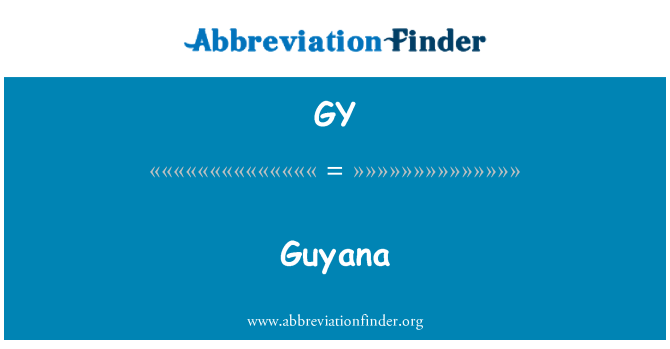GY is the abbreviation for Guyana, the 83rd largest country in the world. Officially the Co-operative Republic of Guyana, Guyana is a country located in South America, bordering 3 countries – Brazil, Suriname, and Venezuela. Georgetown is the capital city of Guyana. Top 10 biggest cities are Georgetown (population: 235,006), Linden (population: 44,679), New Amsterdam (population: 35,028), Anna Regina (population: 12,437), Bartica (population: 11,146), Skeldon (population: 5,848), Rosignol (population: 5,771), Mahaica Village (population: 4,856), Mahdia (population: 4,189), and Parika (population: 4,070).
Country Profile
- Capital: Georgetown
- Language: English
- Area: 214,970 km2
- Population: 783,758
- Currency: Guyanese dollar (GYD)
- Time zone: UTC-4
- Calling code: 592
- ISO 2-Letter Abbreviation: GY
- UN 3-Letter Abbreviation: GUY
- Internet TLD: .gy
- State Government Website:
List of Guyana Acronyms
The most commonly used abbreviations about Guyana are GY which stands for Guyana and GYD which means Guyanese dollar (Guyana currency). In the following table, you can see all acronyms related to Guyana, including abbreviations for airport, city, school, port, government, and etc.

Geography
Around 80 percent of Guyana is covered by rainforests with a particularly large biological diversity. Nearly 25 percent of the world’s rainforest is on the Guyana Plateau in northeastern Amazon (which is shared between the countries of Brazil, Suriname, French Guiana and Guyana). The nature of the Atlantic coast in the north is characterized by a narrow and fertile coastal strip. Within the coastal strip, nature is more hilly.
The climate is tropical, with year-round heat and a lot of rainfall. On the coast it is rainy season from April to August, and from December to January. Inland, it rains most from May to September.
Due to Guyana’s many rivers and large amounts of rainfall, floods and floods are constant threats. In addition, harvesting of the rainforest contributes to the floods and floods becoming larger, as bare and cultivated land can more easily be washed away or flooded than forested areas. Harvesting of the rainforest also threatens the rich animal and plant life in the region. Several organizations and countries, including Norway, are actively working to save the rainforest in Guyana.
History
Originally, Guyana was inhabited by Caribbean and Arawak-speaking people. Most lived as nomads until the area was colonized by the Dutch Empire in the 16th century. Guyana remained a Dutch colony throughout the 17th century, before the area was divided between the Netherlands (Dutch Guyana; now Suriname), France (now French Guyana), and in the 1800s, England (now Guyana). The colonial powers transported many slaves from Africa to Guyana to work on the plantations. When slavery was banned in 1834, colonial powers began to import workers from India. The country has long been characterized by social tensions between the descendants of these two ethnic groups.
Guyana became an independent state in 1966 and was ruled by various socialist governments until 1992. The country was marked by great contradictions between the ethnic Indian and the ethnic African population. Politically, the country had close ties to the Soviet Union and other communist states until the 1980s. When poorly governed state companies and planning economics were about to lead to economic collapse in the 1980s, the country shifted to a market economy. At the same time, the country broke the close ties with other communist countries, and allowed for more democratic elections.
Society and politics
Guyana is a republic where the president is the head of state. The president is nominated by a nationally elected National Assembly, which has the legislative power in the country. The president himself chooses the prime minister and the government, and together they make up the executive power in the country.
Since independence, Guyana’s policies have been characterized by ethnic tensions, repression, corruption and border conflicts with neighboring countries. The unrest has led to between 500,000 and one million Guyanese emigrating to other countries. The country also struggles to follow international guidelines against gender discrimination and oppression based on orientation. Abuse and violence against women and sexual minorities is widespread and is rarely prosecuted or reported.
The Guyanese community is strongly characterized by major social inequalities. The dividing line goes between the often poorer Indian descendants in the countryside and the richer African descendants in the cities. Among other things, health care, schools, infrastructure and other social benefits are less developed in rural areas where the Indian population is greatest, while there is an overwhelming African descendants in positions of power in society, such as the police, military and politics.
Economics and Commerce
Despite many natural resources, Guyana is one of the poorest countries in Latin America. The economy is heavily dependent on exports of bauxite, gold and agricultural products such as sugar and rice. However, poorly developed infrastructure has made exports of natural resources unprofitable. The country has also accumulated large external debt following loans and financial support from the International Monetary Fund and the World Bank. The transition from a planned economy to capitalism in the early 1990s also led to economic growth, and in recent decades foreign debt has declined significantly, but is still a burden on the country’s economy.
The differences between the poor and the rich are a major challenge for Guyana. Over one third of the population lives in poverty, while around 14 per cent live in extreme poverty. These inequalities, together with the political and social unrest, have made the country vulnerable to corruption and crime. Among other things, the lack of political control has led to the country becoming a transport hub for the smuggling of drugs and weapons from South America to Europe and the United States. This has led Guyana to have one of the highest murder rates in South America.
View this article in other languages:
Deutsch – Français – 繁體中文


